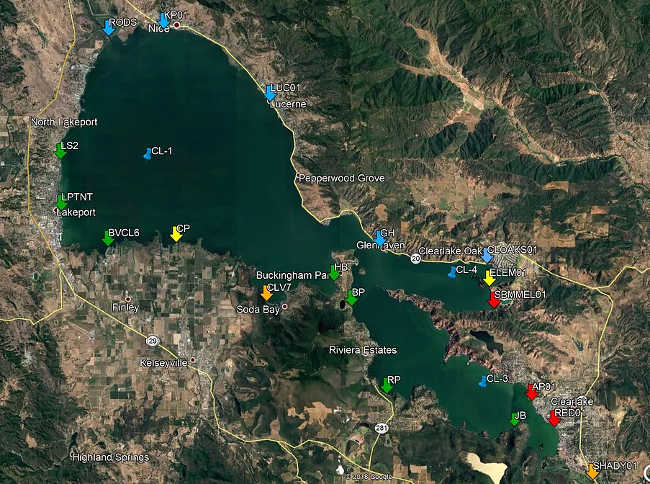
LAKE COUNTY, Calif. – Lake County Public Health is urging boaters and recreational users to avoid direct contact with or use of waters containing blue-green algae, or cyanobacteria, in Clear Lake.
The recommendation is based on the potential health risks from the algae, which is currently blooming at varying levels in all three arms of the lake – Upper Arm, Oaks Arm and Lower Arm.
The Big Valley Band of Pomo Indians and Elem Indian Colony conduct extensive monitoring of Clear Lake.
The most recent test results for cyanotoxins from Aug. 7 confirmed “danger” levels of 20 micrograms per liter, or µg/L, at several locations, triggering health warnings.
The sites where the danger levels were found include:
– Sulphur Bank mercury mine, 4,800 µg/L.
– Austin Park Beach, 230 µg/L.
– Redbud Park boat launch, 24 µg/L.
Warning levels were found at Soda Bay Cove, 13 µg/L, and Cache Creek, 8.7 µg/L, while caution levels were confirmed at Elem Indian Colony, 3.7 µg/L, and Lakeside County Park, 2.9 µg/L, according to the Big Valley Rancheria monitoring Web site.
In recent weeks, the California Department of Water Resources issued an algal bloom warning advisory for Pyramid Lake in Los Angeles County and reported danger levels of cyanotoxin in San Luis Reservoir in Merced County.
Lake County officials said blue-green algae can pose health risks, particularly to children and pets.
Public Health urges people to choose safe activities when visiting the Oaks Arm and parts of the Lower Arm of Clear Lake and wherever blooms are visible. It is strongly recommended that people and their pets avoid contact with water and avoid swallowing lake water in an algae bloom area.
Sulphur Bank mercury mine site is close to a private drinking water supply. The Big Valley Band of Pomo Indians and Elem Indian Colony will be following up with these drinking water suppliers. The Redbud Park boat launch location also is close to a drinking water supply, and sampling of drinking water at the site will occur on Aug. 17.
Cyanotoxin are produced by bacteria called cyanobacteria. They are an essential part of the environment that have existed for millions of year and produce oxygen.
Under certain conditions, they multiply excessively and form visible clumps that can appear as cut grass in the water or blue-green, white or brown foam, scum or mats that can float on the water’s surface and accumulate along the shoreline and boat ramp area.
On occasion, they produce toxins that can cause harmful effects in people and animals if exposed through ingestion, inhalation of aerosolized water or direct contact. As environmental factors change, most harmful algae blooms resolve over time.
However, when cyanotoxin are known to be present, re-testing the water after it has cleared and allowing at least two weeks to pass after no toxins are found is recommended
Get medical treatment immediately if you think that you, your pet, or livestock might have been poisoned by blue-green algae toxins. Be sure to alert the medical professional to the possible contact with blue-green algae. Also, make sure to contact the local county public health department at 707-263-1090.
To see harmful algal blooms reported statewide, visit https://mywaterquality.ca.gov/habs/index.html
For a phone app to monitor blooms, visit https://www.citsci.org/CWIS438/Browse/Project/Project_Info.php?ProjectID=822&WebSiteID=7.

 How to resolve AdBlock issue?
How to resolve AdBlock issue? 



